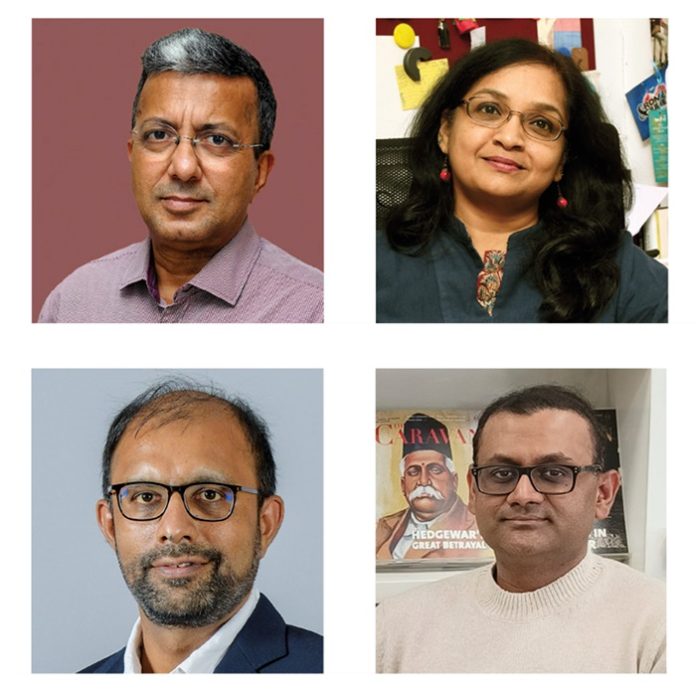
The Indian print news magazine industry is at a crossroads. With the advent of digital news media platforms, social media sites and OTT platforms, coupled with a decline in magazine readership during the Covid-19 pandemic, news magazines are trying in various ways to reinvent themselves to keep pace and stay relevant to changing readership patterns.
Correspondent Priyanka Tanwar spoke to Ruben Banerjee, journalist, author of Editor Missing: The Media in Today’s India and former editor of Outlook, Vaishna Roy, editor of Frontline, Pundi Sriram, CPO of The Hindu Group, and Anant Nath, executive publisher at Delhi Press and editor, The Caravan to know more about India’s news magazine sector and what needs to be done for the industry to stay afloat.
The first of two articles looks at the current scenario of news magazines along with the challenges of going digital. The second part delves into strategies for targeting readers and bringing them back to print, and steps publishers might take to revive news magazines in the country.
The state of Indian news magazines is bleak as the number of “good news magazines” has declined rapidly, Ruben Banerjee said, adding that news magazines are losing out as the internet, TV, OTT and other platforms are available at the push of a button. “Also, with readers’ attention span and readership habits changing, magazines, generally, have not been able to keep pace with the changes. If a magazine has to do well in the current circumstances, it must excel at what it is supposed to do. The most important point is there has been a general bankruptcy of ideas among magazines,” he said.
According to Banerjee, the media in India is apprehensive of criticizing the government; free and independent journalism is not being practised anymore as journalists are not reporting what they ought to be reporting. Instead, he said they are focusing on softer areas such as art, culture, forests, and cinema, which do not hurt the government’s sentiments. Banerjee said he does not suggest that these topics shouldn’t be covered. “However, these are being covered mostly to make peace and not to upset the powers that rule…So, there is a technical shift combined with a bankruptcy of ideas. Most magazines, barring one or two exceptions, have generally dropped the ball and they are not really up to the mark.
“If news magazines have to survive, they have to come up with great content that reflects everyday life, takes up issues, and talks about the current scenario or situation, otherwise you are just filling up the pages with irrelevant stuff, which you or I will not bother about,” he added.
Magazines such as Frontline and Outlook have been revamped or redesigned recently for a fresh look and feel. But do such overhauls help the magazines in any way? Banerjee feels it is a good exercise as it reinfuses some fresh ideas and a fresh look. However, what would finally make a difference, if at all, would be the content – what you are writing, whether you are shedding light on the real situation. If a magazine is not strong on content, however good it might look, it doesn’t make a difference. The paper may be glossy or the print good, but it would still be hollow without content, “It will neither turn the fortunes of the magazines nor do any good to the readers. I can bring out a shiny magazine, but if the content is all junk, how does it matter? What would truly revive a magazine is what kind of stories you are telling and whether you are doing honest journalism, and if you are not being honest,” Banerjee said.
News magazines in India have been severely overtaken by television and the internet, said Vaishna Roy, generally echoing Banerjee’s sentiment. “This is not a problem in India alone, it’s a global issue. However, I feel that there is a definite space for niche magazines such as Frontline in India because it has earned reader’s respect and there is a value that the readers place on its integrity. Readers keep coming back to us. In the larger news magazine universe that is not doing very well, I think Frontline is doing pretty well,” she said.
According to Anant Nath, there is the problem of the medium per se – where news magazines compete with the 24 x 7 digital news environment. The question that most news magazines around the world are grappling with is how to keep the content relevant. Earlier, a newsweekly would give an analysis of content over the past one week and because there was no digital news, that was of great value to the reader. Today, because there’s so much that has come out by the time a weekly magazine hits the stand, the old model has very little relevance. Therefore, most news magazines have had to go for a slightly more feature-ish approach, he added.
The Caravan is not a weekly news magazine but a monthly one. “Our approach from the beginning has been that we are not a part of the news cycle. We want to create stories that are extremely long form, with an eye on the future so that even if you want to read the story more than five months from now, it would be relevant. That’s why we are not tied to the news cycle,” he added.
According to Nath, the big journey of most news magazines is to find that space where the content doesn’t become obsolete by the time they hit the stand, which is important because not everyone has been able to do that. “This is where most of them have lost circulation. Again, everybody is trying to find an answer, they are trying to create a niche. Some magazines such as Outlook and Frontline have gone towards the feature way. Everybody is trying to adapt themselves to disassociate with breaking news and go heavy on features that have more research, more rigorous reporting, with a greater shelf life,” he said.
“The relevance of news brands will remain. Potential readers are increasingly skeptical of what they read on digital media and what they see on WhatsApp – one doesn’t know what is fake or misleading. After all this quick-fix content and a lot of WhatsApp-friendly content – I think people want some amount of trust that what I am reading is from a trustworthy source,” he says.
Nath feels news magazines have a great potential to ensure their relevance because ultimately they are seen as brands with a rigorous editorial process and a certain amount of trust. So whatever content they put out has gone through multiple levels of fact-checking, thinking and ideation. And that’s what all news magazine publishers should decide – not to compete on something that’s not to their advantage, but create niches on subjects that are their position of strength,” he says, in agreement with Roy.
Focus on digital
New platforms such as News18 do long-form video stories, Banerjee said, suggesting it’s a good idea. “Finally, what would determine the true success of a digital platform is the kind of content you are covering, if the content is contextual and free, independent, and fearless. Only then does it make a substantive difference, otherwise, it will just be run-of-the-mill content, and who cares for such substandard stuff.”
According to Roy, there is a very strong digital space for magazines and Frontline is one of the most widely read magazines in India online. “We have a healthy digital subscription base, adds Pundi Sriram, “at the macro level, magazine readership is declining but at the same time Frontline provides a unique perspective on India. It is a leading space for debate in the country and we want to continue leading that debate. “We don’t see the digital readership declining. We see it growing dramatically. It is important that the image and print of Frontline reflect its online presence,” he added.
Roy says she has received a positive response for their digital product. “You might think no one would subscribe to a magazine, but you will be amazed to know we have the largest subscriptions right now among news magazines in India.” Going forward, the plan is to pay more attention to the digital product. Earlier, Frontline print issues would be reproduced on the website – now, they have a lot of stuff that is digital-exclusive – stories, videos, and explainers. “We recently launched our app, which is doing very well. We realized the need to be present across social media – so we have X (Twitter) and Instagram handles. We have young people who are operating these handles,” Roy adds.
Roy says the entire organization is very conscious of the digital game. “Considering our legacy, we already think we have done a great job, and we are only going to intensify it in the days to come.”

















